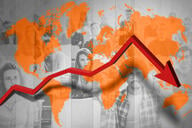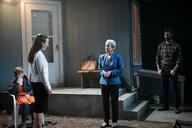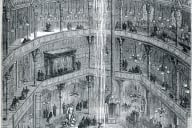You have /5 articles left.
Sign up for a free account or log in.
In the wake of Martin Luther King Jr.'s assassination on April 4, 1968, a wave of riots erupted throughout the United States -- leading to the occupation of Baltimore, Chicago, and the District of Columbia by federal troops and the mobilization of the National Guard in a dozen more. The violence lasted for a week. Clay Risen gives some numbers in the opening pages of A Nation on Fire: America in the Wake of the King Assassination, just published by John Wiley & Sons: "39 people were dead, more than 2,600 were injured, and 21,000 had been arrested. The damages were estimated at $65 million--about $385 million today."
But when Risen, the managing editor of the journal Democracy: A Journal of Ideas, told people he was working on a book about the '68 riots, he says they often assumed he meant the police melee at the Democratic national convention in Chicago a few months later. The post-assassination upheaval -- which engulfed more than 100 cities -- gets a brief nod in accounts of the Sixties, of course; yet the details remain vague, as if our historical memory had somehow erased most of them. Drawing on contemporary accounts, government reports, interviews, and archival sources, Risen presents a narrative history of some of the events of that catastrophic week.
"A race war did in fact come to America that day," he writes, "but it turned out to be a cold war, not a hot one. When the smoke cleared and the sirens ran down, an invisible wall went up between urban and suburban America, every bit as real as the one in Berlin.... In the worlds of legal theorist Jonathan Simon, in the 40-year wake of the riots, 'Americans have built a new civil and political order structured around the problem of violent crime.'" But evidence suggests that the riots were hardly the work of street thugs. "There was no 'typical' rioter," notes Risen, "but the statistically average profile was better educated and more likely to be employed than most people in the riot area....Such results underscore an alternative theory of ghetto rioting: that it was at least as much an expression of protopolitical anger as it was of opportunism and common criminality."
With its emphasis on the political logic of racial backlash, A Nation on Fire shares themes with Rick Perlstein's Nixonland -- but it also seems strangely contemporary at a time when fresh surges of "protopolitical anger" are in the air, worldwide. (Street demonstrations have just toppled the government in Iceland, for example.) Risen agreed to answer a series of questions about his book by e-mail. A transcript of our exchange follows.
Q:The upheavals of early April 1968 seem to be a kind of blindspot in our historical memory -- something not entirely obliterated perhaps, but underrepresented, at any rate. How do you understand this? Is it the forgetfulness of trauma? Or do the events themselves somehow resist being incorporated into accepted narratives about the period?
A: Both, and there's a political element, too. It's hard to imagine today, but King was a very controversial figure at the time of his death -- not only was he still opposed by millions of racist and bigoted whites, but his turn toward antiwar and prolabor activism in 1967 and 1968 distanced him from many racial moderates and liberals as well. And, sadly, the civil rights movement had to work hard to distance itself from the annual riots of the mid- to late 1960s, which many Americans felt was a direct consequence of black activism. Not surprisingly, then, the urge over the last 40 years has been to memorialize Martin Luther King's life, which almost by necessity excludes a discussion of the rather ironic violence that followed his death.
And so while I do think there was an element of historical amnesia resulting from national trauma -- after all, very little is known, at least popularly, about other major riots of the 1960s--I think it is also the result of conscious choices in the crafting of civil rights history.I believe those choices, to be clear, were the right ones at the time. But of course there are unintended consequences of such selective history writing. Because few things are ever, as you say, "entirely obliterated," we still have a vague knowledge that massive violence occurred, but a skewed understanding of what actually happened.
Q:What is the most common misunderstanding about the aftermath of MLK's assassination? And what consequences follow from getting that right?
A: There are so many. But I would say one of the most common is the role of black radicals in starting (or not starting) the riots. This is not unique to April 1968 -- in the wake of almost every riot during the 1960s, efforts were made to uncover plots and hunt down the radicals that formed them. Congress even held several rounds of hearings on the question, despite repeated reports by post-riot commissions finding no link between radicals and the riots at all.
Stokely Carmichael looms large here. In April 1968 he was out of SNCC and dabbling with the Black Panthers; at the same time, he was drawing closer to King and, having settled in Washington, was putting together the Black United Front, a militant but ecumenical group that drew equally from fringe groups and church leaders. At the same time, he was being hounded by the FBI and Congress for supposedly instigating many of the decade's worst riots (he was, almost literally, the black bogeyman for many whites, the catchall explanation for the complexities of urban violence).
Naturally, when violence broke out in Washington the night of King's murder, all eyes turned to Carmichael as the cause, even though -- as I demonstrate in the book -- he was if anything trying to keep the peace in the city's streets. It's hard to know what he was really thinking -- whether he actually opposed violence as a response, or whether he merely opposed unstructured mob violence -- but the point is the same. Nevertheless, faulty and sensationalist reports immediately pegged him as the cause, and even today I come across accounts that place the blame largely, if not wholly, on Carmichael.
This sounds like a historical debaters' point, but understanding the role of black radicals in the 1960s is critical to getting a complete picture of the civil rights movement, race relations, intra-racial politics, and of the political backlash that followed. I'm not sure such a measured understanding was possible then, but I believe it is now, 40 years later.
Q:You quote predictions of impending urban guerilla warfare appearing in mainstream American publications months before King was assassinated. You also show that the government took the possibility of race war very seriously -- drawing up contingency plans that sound nearly as detailed as any preparation for a Soviet attack. Was the subsequent tendency to blame the riots on radicals just a matter of the authorities seeing what their anxieties told them to expect? At what point did that expectation of guerilla warfare fade away? Or did it?
A: There were really two currents in the military's response to domestic riots in the 1960s. On the one hand was what you might call the conservative wing, which saw any domestic activity as a drain on military resources at the height of the Vietnam war, a risk to civil liberties, and a potential PR disaster. On the other hand, there was an activist (for lack of a better word) wing that saw domestic radicalism -- steeped as it often was in Marxist rhetoric -- as an obvious extension of international Communism. (There were others, not in either wing, who gladly accepted any additional duties because they meant more resources and more political clout.)
Given the propensity among the media, the public, and politicians to blame rioting on organized radicals, it was easy for this wing to argue that the riots were ultimately a part of a communist plot to subvert American social order. These were the ones who pushed aggressively on domestic surveillance efforts, as well as massive allocations of resources for domestic deployments.
I don't want to push this element too far -- relatively few military officials fully believed that the riots were part of a communist plot. But conversely, very few could dismiss it completely. And so, to be better safe than sorry, even those who had significant reservations remained silent, at least until, after 1968, urban mass violence began to recede.
As I point out in the book, this is one area where the story of the riots and the government's response bears heavily on today's obsession with homeland security. In both instances there is a "better safe than sorry" mentality and a willingness, even an eagerness, to put civil liberties on the scales against (often imagined) threats to domestic security. Sadly, the lessons of the 1960s with regards to domestic surveillance and military operations in the homeland were largely forgotten, and we are only now relearning them.
Q:The common white perception of the riots--and a major factor shaping the backlash-- was the belief that they were the work of criminals, hooligans, and riffraff. Would you talk a bit about what you learned about the people who took to the streets, and about how the process of disinhibition played itself out?
A: Yes -- the white response was incoherent in that regard. It assumed that the rioters were both instigated by radicals and, at the same time, self-interested riffraff. It was a difficult issue for liberals to address. The riots were clearly political in nature -- or, in sociology-speak, protopolitical -- in that they were a mass response to unacceptable conditions in the inner-city, usually instigated by a particular event, like an overly aggressive arrest, as in Watts. At the same time, they weren't fully political in that they weren't goal-oriented; they were an expression of rage, but little else, and there was certainly no organization.
An entire cottage industry of "riotology" -- a mix of criminal justice, political science, and sociology -- emerged in the 1960s to explain precisely what was happening in the inner-city (partly imported from Europe, where mass violence had long been a focus of study). The consensus view, and one I agree with, is that many inner-cities in the mid- to late 1960s were never wholly peaceful, and that riots were simply spikes in an always-on-edge, boiling ghetto rage. Low-level violence against local merchants and symbols of authority was common, and short-lived mass violence was frequent throughout the country, even if it went below the general public's radar.
What was necessary to set off a full-fledged riot, though, was a catalyst and a precise mixture of factors -- a large crowd, a small police presence, and a series of precipitating events. (In Washington a few days before King died, there had been a near-riot at a drug store after the manager accused a black teen of stealing.) At that point, all that was needed was a spark - -what sociologists call a "Schelling incident," in which a symbolic violation of the law goes unanswered, demonstrating that, suddenly, there was everything to gain (loot, catharsis) with little risk of punishment for mass violence.
Q:The riots appear to have been catalytic in creating a deep shift in American politics -- the collapse of the New Deal coalition, the emergence of "silent majority" conservatism. Is that a fair assessment?
A: I'm not sure I'd go so far as to say that the riots alone caused the deep shift in American politics, though they were certainly an important part of the story. What I argue in the book is that riots, particularly the widespread riots of April 1968, helped make manifest a deep and widely felt sentiment among America's increasingly suburban white middle class -- namely that liberalism had stopped working for them, and instead started working for economic and racial groups that were inimical to their newly established social order.
In simpler words, whites had managed to escape the city and establish a politically moderate, racially exclusive utopia; from there, they could look back on the cities and, seeing violence amidst such extensive and expensive government support, decide that liberalism had failed the country. The extremes of inner-city life--the crime, the radicalism, the riots--helped unify and "desublimate" anti-urban conservatism along racial lines, which in turn set the stage for the anti-civil rights backlashes of the 1970s, from suburban secessions to anti-busing campaigns.
This long-wave backlash fed the candidacies of every president from Richard Nixon to George W. Bush, including Jimmy Carter and Bill Clinton, both of whom expertly harnessed anti-big government sentiment to liberal, or at least Democratic, ends. The question surrounding Barack Obama's liberal ascendancy is whether it is fueled by anything more than a visceral reaction against Bushism--if it does, in fact, signal an end to 40 years of anti-urban, anti-liberal politics.
Q:A wave of food riots erupted in several countries last year. Not long ago Robert Wade of the London School of Economics suggested that more international civil unrest is likely in the months ahead, starting perhaps this spring: "It will be caused by the rise of general awareness throughout Europe, America and Asia that hundreds of millions of people in rich and poor countries are experiencing rapidly falling consumption standards; that the crisis is getting worse not better; and that it has escaped the control of public authorities, national and international." The outpouring of misery in response to a political assassination is one thing; hunger and economic uncertainty another. But there does seem to be something in common: "the awareness...that the crisis is getting worse not better." If so, what's the lesson here?
A: I would caution against drawing too many parallels between the riots of then and the riots of today -- context is very important, and I simply don't know enough about today's food riots to comment. That said, on a certain level, a commodity riot is a commodity riot. People feel they are being deprived of a good they rightfully deserve, at least at a fair price. In 1960s-era inner-cities, residents knew they were being charged extra for the same goods as white suburbanites; in today's developing countries, people can see the price of foodstuffs going through the roof.
As you say, the critical issue is the trend line. In the 1960s, inner-city residents expected, with good reason, that life should be getting better, and yet it was only getting worse for them. In developing countries today, several years of growth in the standard of living suddenly gave way to spiking food prices and commodity shortages. In both cases, the critical factor is a sense of loss of control after society has seemingly promised more of it. Is it any surprise that some people turn to violence in order to regain that control?




